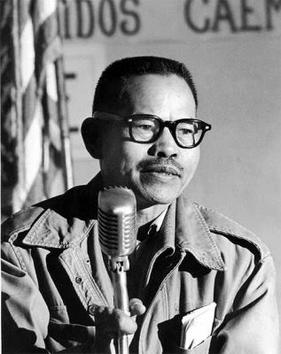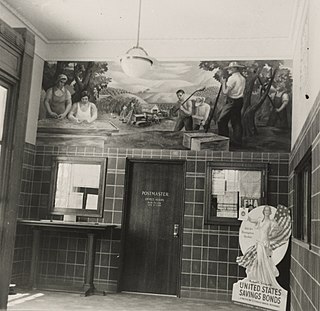
The United Farm Workers of America, or more commonly just United Farm Workers (UFW), is a labor union for farmworkers in the United States. It originated from the merger of two workers' rights organizations, the National Farm Workers Association (NFWA) led by César Chávez and Dolores Huerta and the Agricultural Workers Organizing Committee (AWOC) led by organizer Larry Itliong. They allied and transformed from workers' rights organizations into a union as a result of a series of strikes in 1965, when the Filipino American and Mexican American farmworkers of the AWOC in Delano, California, initiated a grape strike, and the NFWA went on strike in support. As a result of the commonality in goals and methods, the NFWA and the AWOC formed the United Farm Workers Organizing Committee on August 22, 1966. This organization was accepted into the AFL–CIO in 1972 and changed its name to the United Farm Workers Union.
The Oxnard strike of 1903 was a labor rights dispute in the southern California coastal city of Oxnard between local landowners and the majority Japanese and Mexican labor force.

Philip Villamin Vera Cruz was a Filipino American labor leader and farmworker. He helped found the Agricultural Workers Organizing Committee (AWOC), which later merged with the National Farm Workers Association (NFWA) to become the United Farm Workers (UFW). As the union's long-time second vice president, he worked to improve the working conditions of migrant workers.

The Delano grape strike was a labor strike organized by the Agricultural Workers Organizing Committee (AWOC), a predominantly Filipino and AFL-CIO-sponsored labor organization, against table grape growers in Delano, California to fight against the exploitation of farm workers. The strike began on September 8, 1965, and one week later, the predominantly Mexican National Farmworkers Association (NFWA) joined the cause. In August 1966, the AWOC and the NFWA merged to create the United Farm Workers (UFW) Organizing Committee.

Ruth Milkman is an American sociologist of labor and labor movements. She is Distinguished Professor of Sociology at the CUNY Graduate Center and the director of research at CUNY School of Labor and Urban Studies. Between 1988 and 2009 Milkman taught at the University of California, Los Angeles, where she directed the UCLA Institute for Research on Labor and Employment.
Employers Group was founded as the Merchants and Manufacturers Association (M&M) in 1896 in California. It has become a worldwide organization advocating for employers and giving guidance about employment laws and regulations, professional development, consulting projects, and compensation and workplace trends surveys.

The Salad Bowl strike was a series of strikes, mass pickets, boycotts and secondary boycotts that began on August 23, 1970 and led to the largest farm worker strike in U.S. history. The strike was led by the United Farm Workers against the International Brotherhood of Teamsters. The Salad Bowl strike was only in part a jurisdictional strike, for many of the actions taken during the event were not strikes. The strike led directly to the passage of the California Agricultural Labor Relations Act in 1975.
The California Agricultural Labor Relations Act (CALRA) is a landmark statute in United States labor law that was enacted by the state of California in 1975, establishing the right to collective bargaining for farmworkers in that state, a first in U.S. history.

Modesto "Larry" Dulay Itliong, also known as "Seven Fingers", was a Filipino-American union organizer. He organized West Coast agricultural workers starting in the 1930s, and rose to national prominence in 1965, when he, Philip Vera Cruz, Benjamin Gines and Pete Velasco, walked off the farms of area table-grape growers, demanding wages equal to the federal minimum wage, that became known as the Delano grape strike. He has been described as "one of the fathers of the West Coast labor movement."
The Watsonville riots was a period of racial violence that took place in Watsonville, California, from January 19 to 23, 1930. Involving violent assaults on Filipino American farm workers by local white residents opposed to immigration, the riots highlighted the racial and socioeconomic tensions in California's agricultural communities.

The California agricultural strikes of 1933 were a series of strikes by mostly Mexican and Filipino agricultural workers throughout the San Joaquin Valley. More than 47,500 workers were involved in the wave of approximately 30 strikes from 1931 to 1941. Twenty-four of the strikes, involving 37,500 union members, were led by the Cannery and Agricultural Workers' Industrial Union (CAWIU). The strikes are grouped together because most of them were organized by the CAWIU. Strike actions began in August among cherry, grape, peach, pear, sugar beet, and tomato workers, and culminated in a number of strikes against cotton growers in the San Joaquin Valley in October. The cotton strikes involved the largest number of workers. Sources vary as to numbers involved in the cotton strikes, with some sources claiming 18,000 workers and others just 12,000 workers, 80% of whom were Mexican.
The Cannery and Agricultural Workers Industrial Union (CAWIU) was a Communist-aligned union active in California in the early 1930s. Organizers provided support to workers in California's fields and canning industry. The Cannery and Agricultural Workers Industrial Union (CAWIU) dated back to 1929 with the formation of the Trade Union Unity League (TUUL). With industrialization and the advent of the factories, labor started migrating into the urban space. An influx of immigrant workers contributed to the environment favorable to big business by increasing the supply of unskilled labor lost to the urban factories. The demand for labor spurred the growers to look to seasonal migrant workers as a viable labor source. Corporations began to look at profits and started to marginalize its workers by providing sub-par wages and working conditions to their seasonal workers. The formation of the Cannery and Agricultural Workers Industrial Union addressed and represented the civil rights of the migrant workers. Ultimately the CAWIU lost the battle, overwhelmed by the combined alliance of growers and the Mexican and state governments. The eventual abandonment of the Trade Union Unity League led to the dissolution of the CAWIU, which later emerged as the United Cannery, Agricultural, Packing, and Allied Workers of America (UCAPAWA).

The Vacaville tree pruners' strike of 1932 was a two-month strike beginning on November 14 by the CAWIU in Vacaville, California, United States. The strikers were protesting a cut in tree pruning wages from $1.40 for an eight-hour workday to $1.25 for a nine-hour workday. The strike was characterized by multiple violent incidents including a break-in at the Vacaville jail that resulted in the kidnapping and abuse of six arrested strike leaders. The strikers were ultimately unsuccessful in demanding higher wages and fewer hours and the CAWIU voted to end the strike on January 20, 1933.
The El Monte berry strike began on June 1, 1933, in El Monte, California. It was part of the largest California agricultural strike of 1933, organized by the Cannery and Agricultural Workers’ International Union (CAWIU). The berry strike affected local Japanese farm owners and growers.
The Los Angeles Garment Workers strike of 1933 is considered to be one of the most influential strikes in Los Angeles after the passing of the New Deal. The strike is known for being one of the first strikes where Mexican immigrant workers played a prominent role. The garment workers strike occurred in the fall of 1933 in the downtown Garment District in Los Angeles, California. Leaders of the strike, including Rose Pesotta and other members of the International Ladies Garment Workers Union (ILGWU), organized the strike to be culturally orientated in order to include Mexican immigrant workers to fight for union recognition in the garment industry.
The Pacific Electric Railway strike of 1903 was an industrial dispute between Mexican tracklayers and their employers on the construction of the Main Street streetcar line in Los Angeles. The dispute began on April 24 when the workers, known as the "Traqueros", demanded higher wages to match those of the European immigrants working on the same project, and stopped work. It ended on April 29 when the union organising the strike failed to persuade workers on rest of the streetcar system to join the strike, and the labourers returned to work.

The Los Angeles streetcar strike of 1919 was the most violent revolt against the open-shop policies of the Pacific Electric Railway Company in Los Angeles. Labor organizers had fought for over a decade to increase wages, decrease work hours, and legalize unions for streetcar workers of the Los Angeles basin. After having been denied unionization rights and changes in work policies by the National War Labor Board, streetcar workers broke out in massive protest before being subdued by local armed police force.

Elaine Black Yoneda was an American labor and civil rights activist, member of the Communist Party and candidate for political office in California.

The LAPD Red Squad is the common name for a division of the municipal Los Angeles Police Department, in California, United States, that was focused on limiting the activities of left-wing individuals and organizations in the city. Over the course of 50 years, LAPD "gathered some 2 million secret files...on all manner of legitimate dissenters."











